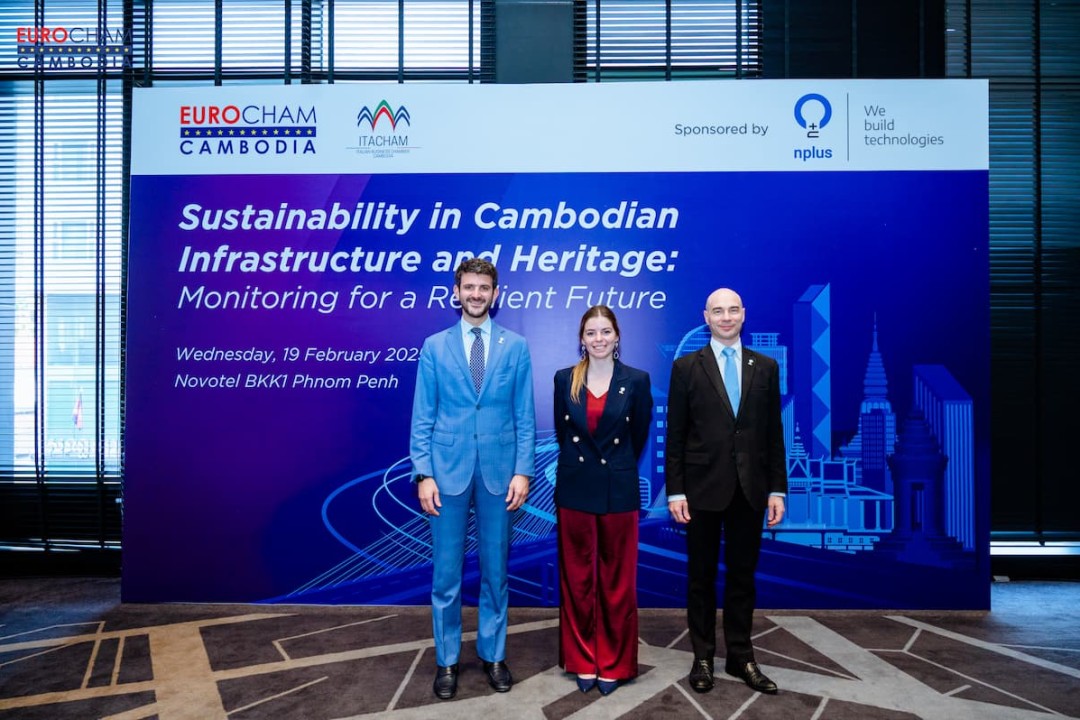How Can Cambodia Benefit From Structural Monitoring Systems?

The Cambodian government has placed a priority on infrastructure development in its aim to become a regional logistics hub but also wants to preserve cultural heritage. To ensure the long-term preservation and success of these, a comprehensive Structural Monitoring System (IMS) is essential was the finding at the Sustainability in Cambodian Infrastructure and Heritage: Monitoring for a Resilient Future conference held in Phnom Penh and organised by EuroCham Cambodia, through its national chapter ItaCham.
Held in partnership with NPlus, an Italian infrastructure company, the conference gathered leading experts, government officials, and industry professionals to discuss the role of Structural Health Monitoring (SHM) in ensuring the sustainability and resilience of Cambodia’s infrastructure and cultural heritage.
Martin Brisson, Executive Director of the European Chamber of Commerce, underscored the necessity of embracing cutting-edge technologies to support Cambodia’s sustainable development.
_20250220_152224.jpg)
How Can SHM Technologies Benefit Cambodia?
NPlus presented its advancements in SHM technologies, emphasising its role in efficient and timely maintenance of infrastructure and successful projects in Italy, as the company presented its key projects in Southeast Asia. Mr. Giordano Riello, President of Nplus, emphasised the strong cultural heritage of Italy and Cambodia and the critical role of SHM in safeguarding both historical landmarks and modern infrastructure.
They argued that Cambodia’s strong focus on innovation positions it as a potential leader in smart infrastructure management and resilient urban development.
SHM technologies can serve as a strategic tool for a rapidly developing nation like Cambodia, and with a strong commitment to innovation, thus Cambodia is well-positioned to integrate monitoring solutions that enhance the safety, efficiency, and longevity of its infrastructure and historical monuments.
Francesca Brighenti, International Sales Director at NPlus (who also is an SHM Specialist, and holds a PhD from the University of Trento) shared Italy’s experiences of bridge and viaduct fragility and examples of several collapses, some of which led to casualties, and impacted citizens and economic activities. One example was Genoa’s Morandi Bridge collapse in 2018 which raised the attention and critical issues of infrastructure maintenance and management.
_20250220_152142.jpg)
“Italy started the structural health monitoring (SHM) process and the Morandi bridge was the very first collapse to allow regulations to manage this infrastructure in an IoT-based way,” she said.
She detailed how SHM technologies enable:
- Optimised infrastructure maintenance, preventing structural deterioration.
- Cost reduction through predictive, data-driven maintenance strategies.
- Enhanced safety for bridges, viaducts, and critical infrastructure.
In terms of Cambodia, she outlined structural monitoring in preserving Cambodia’s historical and architectural heritage, highlighting prime examples where SHM can mitigate risks and ensure long-term conservation.
Panel Discussion - Technology, Infrastructure, and Heritage Preservation
_20250220_152300.jpg)
The event was followed up by a panel discussion moderated by Prof. Riccardo Corrado, Associate Professor at CamEd Business School and Vice-President of ItaCham which focussed on technology, infrastructure, and heritage preservation.
The panel included H.E. Ly Vanna, Undersecretary of the State Ministry of Culture and Fine Arts, H.E. Tan Sokchea, Director General of the General Department of Portable Water at MISTI, Professor Sokuntheary So of Norton University (an architect who worked on Sambo Prei Kuk conservation project) and Alessandro Mangano (partner at Architectural Engineering Consultants)
- H.E. Ly Vanna - stressed the importance of monitoring technologies in preserving crucial historical sites while respecting Cambodia’s cultural heritage.
- H.E. Tan Sokchea - emphasised the role of monitoring technologies in ensuring water infrastructure safety and efficiency.
- Prof. Sokuntheary So - shared her expertise on architectural heritage preservation.
- Mr. Alessandro Mangano - detailed his experience in SHM for the Colosseum in Rome, recognising the value of the Nplus Milan Cathedral case study and highlighting the importance of applying SHM to modern buildings, where design flaws and structural defects may arise.